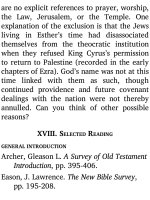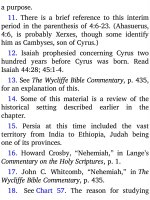Jensens survey of the old testament adam 462
Bạn đang xem bản rút gọn của tài liệu. Xem và tải ngay bản đầy đủ của tài liệu tại đây (79.78 KB, 4 trang )
D. CONTACTS AFTER THE FIRST VISIT
AND BEFORE THE FIRST EPISTLE
Two possible contacts that Paul had with
the Corinthian converts after his rst visit
and before writing 1 Corinthians were
these:10
1. A short visit to Corinth to combat an
incipient opposition to the apostle’s ministry
and to correct other evils. Apparently his
mission was not e ective.11 (Read 2
Corinthians 2:1; 12:14; 13:1-2. Note the
reference to a forthcoming “third time”
visit.)
2. A letter referred to in 1 Corinthians 5:9.
At least part of the letter was written to
correct existing evils in the church. The
letter is not part of the New Testament
canon and was therefore not divinely
inspired Scripture.12
III. BACKGROUND OF 1 CORINTHIANS
A. TIME AND PLACE WRITTEN
Paul wrote this letter on his third
missionary journey, toward the end of his
three-year ministry in the city of Ephesus (1
Cor. 16:8).13 The year of writing was A.D.
55. Read Acts 19:1-20 for a description of
the very fruitful work he was doing at
Ephesus, in the power of God, while in
absentia he was trying to help the
Corinthian church with its problems.
B. OCCASION
Paul was a traveling evangelist who took
to heart the follow-up work of nurturing the
young converts whom he had led to Christ.
He learned of the Corinthians’ problems
through reports (see 1:11 and 5:1) and
inquiries (7:1, 25; 8:1; 11:2; 12:1; 15:1;
16:1) originating with members and leaders
of the church (cf. 1 Cor. 16:17.)If he had
already made a short visit since founding
the church, he also knew of some of the
problems firsthand.
C. PURPOSES
Among Paul’s purposes in writing one of
his longest letters were these: (1) to identify
the basic problems underlying the reports
and inquiries; (2) to o er solutions by way
of doctrine and example; (3) to give
extended teaching on related doctrines; (4)
to give at least a short defense of his
apostleship; (5) to exhort the believers in
the ways of a full, mature Christian life. One
writer has called the book, “The Epistle of
Sanctification.”
D. STYLE
Alford describes Paul’s style with these
words:
The depths of the spiritual, the
moral, the intellectual, the physical
world are open to him. He
summons to his aid the analogies
of nature. He enters minutely into
the varieties of human in rmity
and prejudice. … He praises,
reproves, exhorts, and teaches.
Where he strikes, he heals. His
large heart holding all, where he
has grieved any, he grieves
likewise; where it is in his power
to give joy, he rst over ows with
joy himself.14









